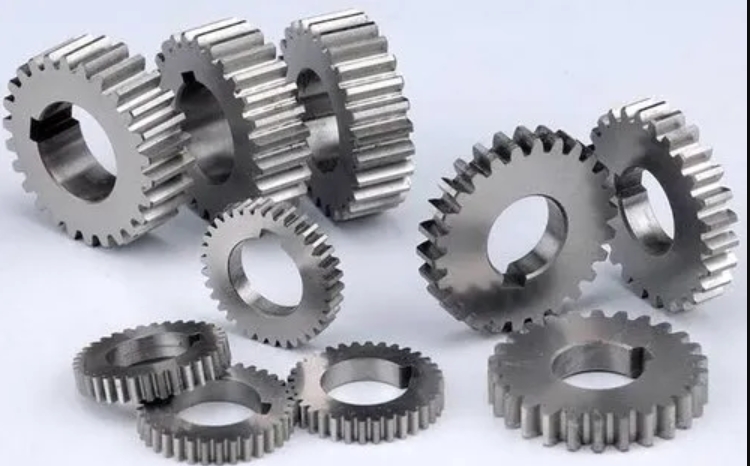With the increasing demand for high-speed and high-power-density gear transmission systems, reducing vibration and noise has become critical. This study investigates the dynamic behavior of spur gears under the combined effects of random transmission errors and stochastic tooth surface friction parameters. We establish a three-degree-of-freedom bending-torsional coupled vibration model and analyze how these stochastic factors influence gear stability and vibration spectra.

1. Dynamic Model of Spur Gear Pair
The lumped parameter model considers six degrees of freedom (three per gear) with nonlinear coupling effects. The governing equations are:
$$m_p\ddot{x}_p + k_{xp}x_p + \sin\alpha \cdot k_m(t)\delta(t) = F_f(t)\sin\alpha$$
$$m_p\ddot{y}_p + k_{yp}y_p + \cos\alpha \cdot k_m(t)\delta(t) = -F_f(t)\cos\alpha$$
$$I_p\ddot{\theta}_p + R_p(t)k_m(t)\delta(t) = T_p(t)$$
$$m_g\ddot{x}_g + k_{xg}x_g – \sin\alpha \cdot k_m(t)\delta(t) = -F_f(t)\sin\alpha$$
$$m_g\ddot{y}_g + k_{yg}y_g – \cos\alpha \cdot k_m(t)\delta(t) = F_f(t)\cos\alpha$$
$$I_g\ddot{\theta}_g – R_g(t)k_m(t)\delta(t) = -T_g(t)$$
Where the relative displacement $\delta(t)$ is defined as:
$$\delta(t) = \sin\alpha(x_p-x_g) + \cos\alpha(y_p-y_g) + R_p\theta_p – R_g\theta_g + e(t)$$
2. Stochastic Parameter Characterization
2.1 Random Transmission Error
The composite transmission error combines deterministic and stochastic components:
$$e(t) = e_m + E\sin(\omega t + \phi) + \xi(t)$$
where $\xi(t)$ represents Gaussian white noise with $\mu=0$, $\sigma^2=0.0005$.
2.2 Stochastic Friction Parameters
Tooth surface friction coefficient varies with roughness:
$$\mu(t) = \mu_0 + \sigma_\mu\xi(t)$$
The equivalent curvature radius contains random components:
$$R_i(t) = r_i\sin\alpha_i + s_\mu + \xi(t)$$
| Parameter | Pinion | Gear |
|---|---|---|
| Teeth | 33 | 26 |
| Module (mm) | 7 | 7 |
| Mass (kg) | 10.6 | 7.43 |
| Moment of Inertia (kg·mm²) | 147,670 | 61,426 |
3. Numerical Analysis and Results
Using fourth-order Runge-Kutta method with step size 0.00015s, we obtain:
| Direction | RMS (mm/s²) | Peak (mm/s²) |
|---|---|---|
| Pinion X | 5.51 | 18.2 |
| Pinion Y | 15.13 | 49.7 |
| Gear X | 7.87 | 25.9 |
Frequency domain analysis reveals significant modulation effects:
$$S_{xx}(f) = \frac{1}{2\pi}\int_{-\infty}^{\infty}R_{xx}(\tau)e^{-j2\pi f\tau}d\tau$$
where $R_{xx}$ represents autocorrelation of vibration signals.
4. Discussion of Stochastic Effects
Key observations from parametric studies:
| Factor | Acceleration Increase | Stability Reduction |
|---|---|---|
| Transmission Error | 65% | High |
| Friction Parameters | 27% | Medium |
The phase portraits demonstrate increased trajectory complexity under stochastic excitation:
$$\lim_{T\to\infty}\frac{1}{T}\int_0^T \mathbf{q}(t)\mathbf{q}^T(t+\tau)dt$$
5. Conclusion
This investigation establishes that spur gear systems exhibit significantly enhanced vibration randomness under combined stochastic transmission errors and friction parameter variations. The developed model provides crucial insights for dynamic design optimization of precision gear transmissions.
Key findings include:
- Random transmission errors increase vibration RMS values by 65% compared to deterministic cases
- Stochastic friction parameters contribute 27% additional vibration energy in high-frequency bands
- Phase space analysis reveals chaotic tendencies under combined stochastic excitation
$$J = \int_0^{t_f} \left[\mathbf{q}^T\mathbf{W}_q\mathbf{q} + \mathbf{u}^T\mathbf{W}_u\mathbf{u}\right]dt$$
This cost function formulation enables future optimal control applications for spur gear vibration suppression.
